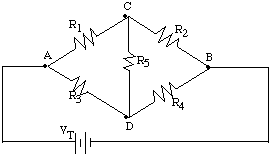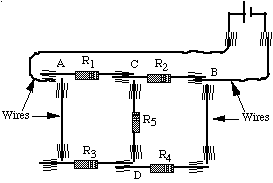KIRCHHOFF'S RULES
Gunn Physics
PURPOSE:
The purpose of this lab will be to gather experimental data for
the circuit below to analyze in light of Kirchhoff's Rules for
electrical circuits.

MATERIALS:
- Circuit Experiments Board
- Digital Multimeter (DMM)
- Resistors
- Battery
- Wires
PROCEDURE:
- Measure and record the resistance of your five resistors,
choosing which ones will be designated R1,
R2, etc.
- Connect the circuit shown below using your resistors. Use
the diagram above as a reference as you record your data. With
no current flowing (the battery disconnected), measure the total
resistance of the circuit between points A and B.

- With the circuit connected to the batteries and the current
flowing, measure the voltage across each of the resistors and
record the values in the Data Table. On the circuit diagram above,
indicate which side of each of the resistors is positive relative
to the other end by placing a "+" at that end.
- Now measure the current through each of the resistors. Interrupt
the circuit and place the DMM in series to obtain your reading.
Make sure you record each of the individual currents, as well
as the current flow into or out of the main part of the circuit,
IT.
RESISTANCE
W
| VOLTAGE
volts
| CURRENT
ma |
| R1 | V1
| I1 |
| R2 | V2
| I2 |
| R3 | V3
| I3 |
| R4 | V4
| I4 |
| R5 | V5
| I5 |
| RT | VT
| IT |
ANALYSIS:
- Determine the net current flow into or out of each of the
four "nodes" in the circuit.
- Determine the net voltage drop around at least three (3) of
the six or so closed loops. Remember, if the potential goes from
negative to positive, treat the voltage as positive (+), while
if the potential goes from positive to negative, treat it as negative
(-).
DISCUSSION:
- Use your experimental results to analyze the circuit you built
in terms of Kirchhoff's Rules. Be specific and state the evidence
for your conclusions.
EXTENSION:
- Build the circuit below and apply the same procedure you used
previously. Analyze it in terms of Kirchhoff's Rules. If possible,
try to analyze the circuit ahead of time and compare your measured
values with the theoretically computed values.

Uploaded 3/6/98



